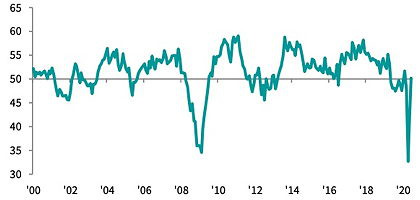UK manufacturing stabilises in June and output edges higher

The UK manufacturing sector showed signs of stabilising in June, following the recent steep downturn caused by the Covid-19 pandemic, according to the latest IHS Markit/CIPS Purchasing Managers’ Index. The seasonally adjusted PMI rose to 50.1 in June, up from 40.7 in May, indicating a stabilisation (not a marked improvement) in operating conditions, while output edged back into growth as factories restarted, lockdown restrictions were loosened and staff returned to work.
Manufacturing production rose slightly for the first time in four months during June, with the intermediate goods sector showing the steepest growth, while consumer goods producers saw only a mild expansion. In contrast, investment goods output fell again, albeit at a much reduced pace.
Business sentiment rose to a 21-month high in June, with more than 63% of manufacturers predicting that output will rise over the coming year.
Although new order intakes fell for the fourth month running in June, the rate of decline slowed further from April's record. By contrast, new export business fell for the eighth month, reflecting low market confidence and the ongoing impact of Covid-19.
Employment fell for the fifth consecutive month in June. Although the rate of decline eased further from April's record, it remained among the steepest in the 28-year survey history.
The current weak economic backdrop led to lower levels of raw material purchasing and further depletion of stocks of purchases and finished goods. The pandemic also continued to cause substantial disruption to supply chains, leading to material shortages, vendor shutdowns and transportation issues.
“June completed a marked turnaround in momentum in UK manufacturing, as the sector switched from April's record contraction back to stabilisation in the space of two months,” comments IHS Markit director, Rob Dobson. “Output edged higher and domestic demand firmed as lockdown restrictions loosened, factories restarted and staff returned to work. Business optimism also recovered to a 21-month high.
“The planned loosening in Covid-19 restrictions on the 4 July should aid further gains in coming months. Although the trend in new export business remains weak, that should also strengthen as global lockdowns and transport constraints ease further.

“The main focus is now shifting towards the labour market,” he continues. “Concerns are rising about the potential for marked job losses, especially once the phase-out of government support schemes begins. The news on that footing is less positive, with June seeing a further reduction in staffing levels and, although easing sharply since April's record, the rate of job loss remains among the steepest in the 29-year survey history. Economic conditions will need to improve markedly across the UK, or some support retained, if the labour market downturn is to avoid becoming more entrenched through the remainder of the year.”
“June’s data shows the sector has dragged itself up from a survey-record low just two months ago into a position of no-change, as optimism rises to its highest levels for almost two years amongst manufacturers,” adds Duncan Brock, group director at the CIPS. “However, output remains at low levels and the sector’s weak position compared to pre-Covid levels means there is a significant amount of catching up to do before manufacturing can relax into a period of growth. Purchasing continues to be hampered by battered and bruised supply chains, logistics difficulties and longer delivery times for the twelfth month in a row as suppliers adjust to the new normal.
“The sector may be springing back into action after lockdown easing, but worse results may be on their way for companies as government support falls away and businesses are left with decisions to make on whether they can weather any continuing storms. Employment levels fell for the fifth month in a row and are still plummeting across all three sub-sectors. As companies nervously look for signs of real growth, shedding costs wherever they can in the meantime, these actions may cause damage that will take some time to fix.”





